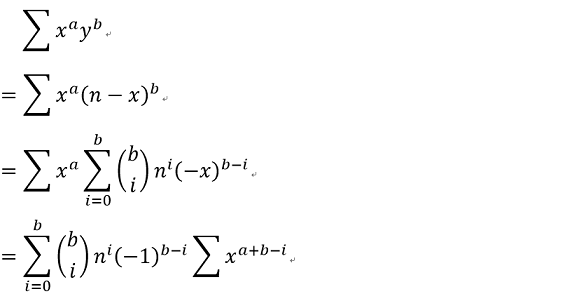交错序列
题目背景:
分析:DP + 矩阵快速幂
第一反应看到数据范围就觉得,可以直接O(n) ~ O(n)搞过去,但是很遗憾常数过大,至少我没有卡过去,换种思路考虑化简一下。
那么我们只需要求得所有方案中0的个数的i次方之和(0 <= i <= a + b),那么我们定义f[i][j][0/1]表示前i位的所有合法方案的0的个数的j次方之和,第i位是0/1,那么显然对于一个f[i][j][1]直接等于f[i - 1][j][0],对于f[i][j][0]相当于把所有的方案中的xi变成(x + 1)i这个可以直接二项式定理获得对应系数,即:
利用矩阵优化即可,注意适当剪枝,复杂度O((a + b)3 * logn)
Source:
/*
created by scarlyw
*/
#include <cstdio>
#include <string>
#include <algorithm>
#include <cstring>
#include <iostream>
#include <cmath>
#include <cctype>
#include <vector>
#include <set>
#include <queue>
inline char read() {
static const int IN_LEN = 1024 * 1024;
static char buf[IN_LEN], *s, *t;
if (s == t) {
t = (s = buf) + fread(buf, 1, IN_LEN, stdin);
if (s == t) return -1;
}
return *s++;
}
///*
template<class T>
inline void R(T &x) {
static char c;
static bool iosig;
for (c = read(), iosig = false; !isdigit(c); c = read()) {
if (c == -1) return ;
if (c == '-') iosig = true;
}
for (x = 0; isdigit(c); c = read())
x = ((x << 2) + x << 1) + (c ^ '0');
if (iosig) x = -x;
}
//*/
const int OUT_LEN = 1024 * 1024;
char obuf[OUT_LEN], *oh = obuf;
inline void write_char(char c) {
if (oh == obuf + OUT_LEN) fwrite(obuf, 1, OUT_LEN, stdout), oh = obuf;
*oh++ = c;
}
template<class T>
inline void W(T x) {
static int buf[30], cnt;
if (x == 0) write_char('0');
else {
if (x < 0) write_char('-'), x = -x;
for (cnt = 0; x; x /= 10) buf[++cnt] = x % 10 + 48;
while (cnt) write_char(buf[cnt--]);
}
}
inline void flush() {
fwrite(obuf, 1, oh - obuf, stdout);
}
/*
template<class T>
inline void R(T &x) {
static char c;
static bool iosig;
for (c = getchar(), iosig = false; !isdigit(c); c = getchar())
if (c == '-') iosig = true;
for (x = 0; isdigit(c); c = getchar())
x = ((x << 2) + x << 1) + (c ^ '0');
if (iosig) x = -x;
}
//*/
const int MAXN = 180 + 10;
int n, a, b, mod;
long long fac[MAXN], inv_fac[MAXN];
inline long long mod_pow(long long a, long long b) {
long long ans = 1;
for (; b; b >>= 1, a = a * a % mod)
if (b & 1) ans = ans * a % mod;
return ans;
}
inline long long c(int n, int m) {
return (n < m) ? (0) : (fac[n] * inv_fac[m] % mod * inv_fac[n - m] % mod);
}
struct matrix {
int n;
long long a[MAXN][MAXN];
matrix() {}
matrix(int n) : n(n) {
for (int i = 0; i < n; ++i)
for (int j = 0; j < n; ++j)
a[i][j] = 0;
}
inline matrix operator * (const matrix &c) const {
matrix ans = matrix(n);
for (int i = 0; i < n; ++i)
for (int k = 0; k < n; ++k)
if (a[i][k])
for (int j = 0; j < n; ++j)
if (c.a[k][j])
ans.a[i][j] = (ans.a[i][j] + a[i][k] * c.a[k][j]) % mod;
return ans;
}
inline matrix operator ^ (const int x) const {
matrix a = *this, ans = matrix(n);
for (int i = 0; i < n; ++i) ans.a[i][i] = 1;
int b = x;
for (; b; b >>= 1, a = a * a)
if (b & 1) ans = ans * a;
return ans;
}
} move;
inline void solve() {
R(n), R(a), R(b), R(mod);
int max = a + b + 1;
fac[0] = 1;
for (int i = 1; i <= max; ++i) fac[i] = fac[i - 1] * i % mod;
inv_fac[max] = mod_pow(fac[max], mod - 2);
for (int i = max - 1; i >= 0; --i)
inv_fac[i] = inv_fac[i + 1] * (i + 1) % mod;
move = matrix(2 * max);
for (int i = 0; i < max; ++i) move.a[i][i + max] = 1;
for (int i = 0; i < max; ++i)
for (int j = 0; j <= i; ++j)
move.a[j][i] = move.a[j + max][i] = c(i, j);
move = (move ^ n);
long long x = 1, ans = 0;
for (int i = 0; i <= b; ++i, x = x * n % mod) {
ans += c(b, i) * x % mod * (move.a[0][a + b - i] +
move.a[0][a + b - i + max]) % mod * ((b - i & 1) ? (-1) : (1));
ans %= mod;
}
std::cout << (ans + mod) % mod;
}
int main() {
//freopen("in.in", "r", stdin);
solve();
return 0;
}

